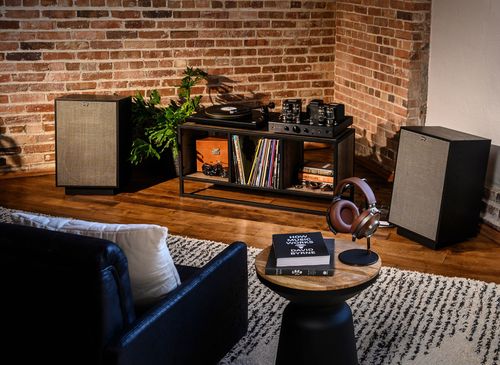
At A Glance:
What Are 2-Way and 3-Way Speakers?
Pros and Cons of 2-Way Speakers
Pros and Cons of 3-Way Speakers
Comparing Performance: 2-Way vs. 3-Way
How to Choose the Right Speaker for Your Needs
When it comes to creating the perfect audio experience, the choice between 2 Way vs 3 Way Speakers plays a pivotal role. Are you aiming to enhance your everyday music sessions or build a home theater that rivals the local cinema? The right speakers can make all the difference. Yet, with options galore, deciding between these two types can feel overwhelming. Do you prioritize simplicity and cost, or are you ready to invest in detail-packed sound worthy of an audiophile's dream? by the time you finish reading, you'll know exactly which type of speaker fits your audio needs.
This guide will break down everything you need to know about 2 Way vs 3 Way Speakers. From how they’re built to the kind of performance you can expect, we’re here to make the decision-making process as smooth as possible for you. Whether you're a casual listener or a sound enthusiast, understanding the differences between 2 Way vs 3 Way Speakers will help you choose the perfect setup.
Find the Perfect Speaker Setup for Your Home
Get the best sound for your speaker needs. Call or visit Paradyme and speak to one of their audio experts to find the best fit for your home.
Learn About Your Audio OptionsWhat Are 2 Way and 3 Way Speakers?

Let’s start with the basics: What are 2 way vs 3 way speakers, and how are they different? Both types deliver sound, but they do it differently based on their components.
2 Way Speakers
A 2 way speaker uses two drivers working together to deliver a range of sound. Each driver handles specific frequencies for clarity and balance:
- Woofer - Handles low frequencies like deep bass and lower midrange tones. It brings depth to bass guitar riffs, powerful beats, and the rumbling effects in action movies.
- Tweeter - Reproduces high frequencies such as vocals, high-pitched instruments, and the crisp shimmer of cymbals. It ensures clarity in every detail of music and audio.
These components are coordinated by a crossover, which splits audio signals into two frequency ranges. Think of it like two roommates sharing chores: the woofer handles the heavy lows, and the tweeter takes care of the sharp highs. Together, they create a balanced sound, though there’s a limit to how much range they can cover.
3 Way Speakers
A 3 way speaker adds a third driver, creating more balance and clarity by dividing sound into three distinct ranges. Here’s the setup:
- Woofer - Handles low-end bass frequencies, delivering those booming explosions and deep beats.
- Midrange Driver - Focuses on mid frequencies, bringing clarity to vocals, guitars, and instruments in the middle range.
- Tweeter - Specializes in high frequencies, delivering crisp details like cymbals and high-pitched vocals.
With three drivers, 3 way speakers provide a more dynamic and immersive sound, making them perfect for audiophiles. The crossover splits sound into three ranges, giving each driver its own role. If a 2 way speaker is a duet, the 3 way is a trio, with added balance and fullness.
Sound Division Made Simple
Think of a concert: the drums (low frequencies) lay the foundation, vocals and guitars (midrange) tell the story, and cymbals and violins (high range) add finesse. A 2 way speaker splits the sound into two parts, while a 3 way separates it into three, resulting in greater clarity and richness.
Learn more: A Guide to McIntosh Turntable Setup: Expert Tips for Perfect Vinyl Playback
How Do They Work?
The magic of 2 way and 3 way speakers lies in how their components work together to deliver sound with precision and clarity. Each driver handles a specific range of frequencies, ensuring no detail is lost, whether you’re listening to music, movies, or podcasts.
Understanding Drivers
- Woofer - The woofer focuses on low frequencies, delivering deep bass sounds that make your heart thump and your floor vibrate. Think of movie explosions, kick drums, or groovy basslines. In both 2 way and 3 way speakers, the woofer provides depth and impact for a full sound experience.
- Midrange Driver (in 3 way speakers only) - The midrange driver handles middle frequencies like vocals and instruments such as guitars and pianos. These sounds add richness and emotional connection. With the midrange driver, 3 way speakers deliver exceptional clarity, especially in genres like jazz, classical, or acoustic music.
- Tweeter - The tweeter handles high frequencies, delivering crisp, delicate sounds. From shimmering cymbals to soaring vocals, the tweeter ensures these details remain sharp and vivid, adding brilliance to your audio.
Together, these drivers create a balanced sound spectrum, ensuring each frequency gets the attention it deserves. This collaboration is what makes 2 way and 3 way speakers deliver an immersive listening experience.
The Role of Crossovers
Crossovers split sound frequencies so each driver handles the range it’s designed for, reducing distortion and improving clarity. Imagine sound frequencies as water through a pipeline: the crossover acts as a filter, directing the right flow to each driver.
In 2 way speakers, the crossover splits the signal into lows (woofer) and highs (tweeter). In 3 way speakers, it divides the signal into lows, mids, and highs, allowing for more detailed and dynamic sound.
Think of it like slicing a cake. With two slices, the flavors blend together; with three, every flavor stands out clearly.
Learn more: Luxury Home Theater: Planning Your Professional Installation
Pros and Cons of 2 Way Speakers

Pros
- Simpler Design
With just two drivers—a woofer for low and midrange frequencies and a tweeter for highs—2 way speakers are simpler than 3 way models. This makes them easier to manufacture, maintain, and troubleshoot.
- Affordable
Fewer components, like one less driver and simpler crossover circuits, make 2 way speakers more affordable. They’re a great option for budget-conscious listeners seeking quality audio.
- Compact Size
With fewer components, 2 way speakers are smaller and lighter. Their compact design is perfect for small spaces like dorms, apartments, or home offices while still delivering impressive sound.
- Straightforward Setup
2 way speakers are easy to integrate into basic audio systems without much technical know-how. They’re ideal for beginners or anyone wanting a quick, hassle-free setup.
Cons
- Limited Frequency Range
Without a dedicated midrange driver, 2 way speakers can sound less balanced. Vocals or instruments might not come through as clearly, with bass or treble sometimes overpowering the mids.
- Less Clarity in Complex Sounds
Music with multiple layers, like orchestral or intricate electronic tracks, may lose definition in the midrange. Instruments or vocals can blend together, reducing the detail in complex soundscapes.
- Not Ideal for Audiophiles
For those seeking perfectly balanced sound across all frequencies, 2 way speakers might disappoint. They lack the depth and richness that audiophiles expect from higher-end setups.
Pros and Cons of 3 Way Speakers

Pros
- Superior Sound Clarity
With separate drivers for lows, mids, and highs, 3 way speakers deliver richer, more detailed sound, ensuring an immersive listening experience.
- Broader Frequency Range
From deep bass to crystal-clear highs, 3 way speakers cover the full audio spectrum, making them ideal for all music genres or soundtracks.
- Perfect for Audiophiles
Designed for sound enthusiasts, 3 way speakers bring out every detail, making them great for high-performance home theaters or music setups.
Cons
- More Expensive
Their advanced design and components come with a higher price tag, making 3 way speakers a bigger investment than 2 way models.
- Bulkier Design
The extra driver makes 3 way speakers larger and heavier, which can be a downside in small living spaces.
- Complex Setup
Setting up 3 way speakers for optimal sound takes more effort. Balancing the sound may require some research or professional assistance, which can be challenging for beginners.
Comparing Performance: 2 Way Speakers vs. 3 Way Speakers

Clarity and Sound Quality
In terms of clarity and sound quality, 3 way speakers excel. With dedicated drivers for bass, midrange, and treble, they deliver depth and balance that 2 way systems can’t match. This separation ensures a richer, more immersive audio experience, especially in genres like classical music or detailed tracks. From the delicate sound of a violin to the strong bass of a drum, the difference is clear when upgrading your home audio system.
Volume and Power Handling
3 way speakers also outperform 2 way systems in volume and power handling. While 2 way speakers handle moderate volumes well, they often distort at higher levels due to shared driver workload. The extra driver in 3 way speakers ensures better power distribution and reduces distortion, making them ideal for higher volumes without sacrificing quality. Whether you’re looking for surround sound or simply decided, I want to upgrade my home audio, 3 way speakers are a solid choice.
Durability and Longevity
Durability is worth considering. 2 way speakers, with their simpler design and fewer components, often last longer in basic setups. However, 3 way speakers are built to handle higher power and deliver superior sound quality, making them a worthwhile investment for audiophile listeners or those seeking custom home audio solutions.
Learn more: High-End Speaker Brands Pushing the Boundaries of Sound
2 Way Speakers
2 way speakers are great for smaller spaces and casual listening. They’re perfect for bedrooms, small apartments, or anyone on a budget. If you’re new to upgraded home audio, 2 way speakers offer an affordable, space-efficient way to improve sound quality.
3 Way Speakers
3 way speakers are best for larger spaces and demanding audio needs. Perfect for home theaters or living rooms, they deliver premium sound for movies or immersive music sessions. Their ability to handle high volumes and complex tracks makes them ideal for serious listeners, audiophile users, and cinephiles. For those looking at home audio Sacramento, 3 way speakers might be the solution to achieving the perfect sound system.
How to Choose the Right Speaker for Your Needs

Ready to decide? Follow this step-by-step guide to find the perfect speaker for your setup:
- Know Your Audio Needs
What do you want from your audio system? Are you a casual music listener or looking for a full cinematic experience? Think about the content you’ll play—music, movies, podcasts—and your comfort level with home audio equipment.
- Set Your Budget
Decide how much you’re willing to spend. 2 way speakers are usually more affordable and great for beginners, while 3 way speakers cost more but offer premium sound. Be realistic, but remember this is a long-term investment for custom home audio solutions.
- Consider Your Space
Room size and layout matter. Can you fit larger 3 way speakers, or do you need compact ones for a smaller area? Bigger speakers work better in open spaces, while smaller ones suit cozy rooms. If you’re setting up in home audio Sacramento, consider consulting local experts for personalized recommendations.
- Test Before You Buy
If possible, try speakers in-store or check online reviews with sound tests. Focus on clarity, depth, and performance at various volumes. Choose speakers that match your style, whether you prefer crisp highs, deep bass, or a balanced mix.
By considering these factors, you’ll be ready to choose a speaker setup that fits your space, budget, and listening style. Whether it’s a 2 Way vs 3 Way Speakers system, the right speakers can transform your audio experience into the perfect surround sound solution.
Final Thoughts
Choosing between 2 way and 3 way speakers depends on your preferences and needs. 2 way speakers, with a woofer and tweeter, are a great choice for simplicity, affordability, and compact design—perfect for smaller spaces or a budget-friendly setup. On the other hand, 3 way speakers include an extra driver, often a midrange, providing richer mids, cleaner highs, and deeper lows. They’re ideal for audiophiles or anyone seeking an immersive listening experience.
While 2 way speakers are great for casual listeners, 3 way speakers elevate music, movies, and audio with more dynamic sound. Take the time to consider your space and priorities, choose wisely, and enjoy every beat and note as it was meant to be heard.
Ready to upgrade your sound setup? Contact Paradyme today and let us help you find the perfect speakers for your needs.
2 Way vs 3 Way Speakers FAQs
3-way speakers excel at delivering a richer sound because they split audio signals into three frequency ranges handled by separate drivers. This division allows for better clarity and detail, especially in mids and lows, providing an immersive listening experience.
To identify if your speakers are 2-way, check for two drivers, typically a tweeter for high frequencies and a woofer for lows and mids. This design ensures a good balance but might lack the dedicated midrange driver seen in 3-way configurations.
A 3-way speaker generally offers more detailed audio because of its dedicated midrange driver, which handles mid frequencies without overloading the woofer. However, 2-way speakers can still deliver impressive sound and might be a better fit for smaller spaces or simpler setups.
Not necessarily. The volume depends on a combination of factors, including sensitivity, power handling, and audio source. While 3-way speakers often provide more richness, the loudness will vary based on the specific model and environment.
Why Trust Paradyme?
Since 1976, our Sacramento business has served the northern California region with unparalleled expertise in Hi-Fi systems, TVs, and car audio. With unparalleled expertise, Paradyme progresses the way forward in modern-day solutions. We foster a strong culture of innovation and knowledge to meet our residential and commercial customers' tech needs with state-of-the-art capabilities that remain unrivaled. Our unbeatable reputation speaks volumes about delivering only the best!
Our team of experts has years of experience and industry knowledge under their belt to provide exclusive, luxury-level service in custom electronics for our customers throughout Sacramento and northern California.
Shop Smart Solutions at Paradyme
At Paradyme, we provide quality top-of-the-line brands for every project. We have experienced technicians who know the right way to install smart home products, car audio and video solutions, home theater options, and much more. Give us a call at 916-481-3900 or stop by today.